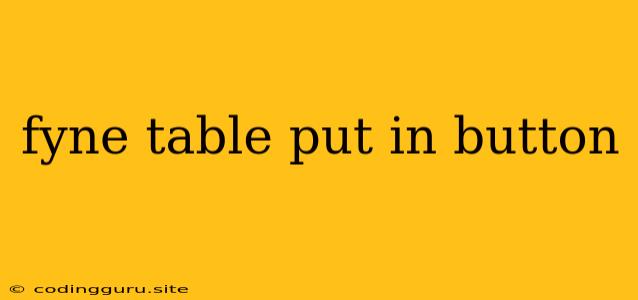Adding Buttons to Your Fyne Tables: A Comprehensive Guide
Fyne is a popular cross-platform GUI toolkit for Go, and tables are a fundamental component for displaying data in a structured way. But what if you need to interact with your data directly within the table? This is where the ability to add buttons to your Fyne tables becomes incredibly useful.
Let's explore how you can seamlessly integrate buttons into your Fyne tables, enhancing user interaction and functionality within your application.
Why Add Buttons to Your Fyne Tables?
Buttons within Fyne tables provide a direct and intuitive way for users to interact with individual data entries. This can significantly improve the usability of your application by:
- Direct Action: Buttons offer a clear way to initiate actions related to specific table rows, such as editing, deleting, or toggling states.
- Improved User Experience: Instead of requiring users to navigate to separate screens for these actions, buttons streamline the process, enhancing user flow and satisfaction.
- Increased Efficiency: By embedding actions within the table itself, users can work more efficiently without needing to constantly switch between different views.
How to Add Buttons to Your Fyne Table
Let's delve into the code and see how we can achieve this. This example demonstrates how to add a button to each row of a Fyne table:
package main
import (
"fyne.io/fyne/v2"
"fyne.io/fyne/v2/app"
"fyne.io/fyne/v2/container"
"fyne.io/fyne/v2/widget"
)
func main() {
a := app.New()
w := a.NewWindow("Fyne Table with Buttons")
// Sample data for the table
data := [][]string{
{"Item 1", "Description 1", "10"},
{"Item 2", "Description 2", "20"},
{"Item 3", "Description 3", "30"},
}
// Create the table
table := widget.NewTable(
func() int { return len(data) },
func() int { return len(data[0]) },
func(i, j int) fyne.CanvasObject {
if j == len(data[0])-1 { // Add button to the last column
// Create a button for each row
button := widget.NewButton("Action", func() {
// Handle button click
fyne.CurrentApp().Quit()
})
return button
} else {
return widget.NewLabel(data[i][j])
}
},
)
w.SetContent(container.NewScroll(table))
w.ShowAndRun()
}
In this code:
-
We create a
widget.NewTableobject. -
The
func(i, j int) fyne.CanvasObjectpart determines what content goes into each cell. -
When the column index
jis the last one (the button column), we create a button usingwidget.NewButton. -
We assign a function to the button's
OnTappedevent, which will be triggered when the button is clicked.
Customizing Button Appearance
Fyne provides flexibility for customizing the appearance of your buttons. Here are some common customizations:
- Styling: You can use Fyne's styling options to change the button's background color, text color, font, and more.
button := widget.NewButtonWithStyle("Action", func() {
// Button Click Action
}, widget.NewButtonWithStyleOptions(
widget.ButtonWithStyle{
TextColor: color.White,
BackgroundColor: color.Blue,
CornerRadius: 5,
}))
- Icons: You can add icons to your buttons using Fyne's
icon.NewResourcefunction.
// Assuming 'edit.png' is an icon file in your assets
icon := icon.NewResourceFromImage(icon.ImageFile("edit.png"))
button := widget.NewButtonWithIcon("Edit", icon, func() {
// Button Click Action
})
Dynamic Actions and Data Handling
To make your buttons more powerful, you'll often need to perform dynamic actions based on the data associated with the row. This typically involves:
- Row Data Access: You need to access the data of the specific row that the button is associated with. This might involve using the
i(row index) value provided by the table'sfunc(i, j int) fyne.CanvasObject. - Data Processing: You may need to process the row data to perform specific actions, like updating the data in a database, sending a network request, or changing the table's display.
Beyond Basic Buttons
While the basic button functionality is a great starting point, you can expand the capabilities of your Fyne table buttons further:
- Dropdown Buttons: Use a dropdown button to provide users with a menu of choices related to a row.
- Progress Indicators: Embed progress indicators within buttons to visually represent ongoing operations.
- Custom Button Components: For advanced button styles or interactions, consider creating your own custom button components.
Conclusion
Adding buttons to your Fyne tables provides a powerful way to enhance user interaction and functionality. By understanding the principles of button creation, customization, and dynamic actions, you can create tables that are not only informative but also highly interactive. This will lead to a more engaging and efficient user experience within your applications.
